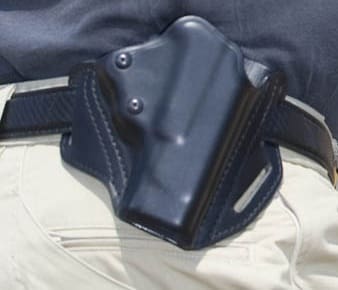 Apparently TTAG wasn’t cool enough to get an invite to Blackhawk’s opening ceremonies for their new factory in Montana. Oh well — we were too busy being awesome doing what we’re doing anyway. But at that event, Blackhawk apparently demo’d a new holster – their GripBrake line – they’re planning on releasing in the coming months that doesn’t use the traditional SERPA trigger finger retention system. Shooting Illustrated has the scoop . . .
Apparently TTAG wasn’t cool enough to get an invite to Blackhawk’s opening ceremonies for their new factory in Montana. Oh well — we were too busy being awesome doing what we’re doing anyway. But at that event, Blackhawk apparently demo’d a new holster – their GripBrake line – they’re planning on releasing in the coming months that doesn’t use the traditional SERPA trigger finger retention system. Shooting Illustrated has the scoop . . .
According to their guy on the ground:
Unlike the Serpa, the second level of retention is not deactivated with the trigger finger. […] As you begin your draw, your thumb comes along your side to assume a master grip. A paddle (which on the production models is going to be bigger than the ones we used) rests close to your body, slightly above the spot your thumb needs to engage the grip. As you squeeze, the second level of retention is automatically disengaged, and pistol is free for presentation.
Sounds a heck of a lot like Safariland’s ALS holster retention method, which I happen to like. A lot. Unlike Blackhawk’s SERPA design, which I absolutely hate.
Blackhawk was careful not to let it appear that they’re replacing the existing line of holsters, though.
Blackhawk claims it is just expanding the line, not addressing criticism. Let’s face facts, with the 4 millionth Serpa being shipped in the next 4 to 8 weeks, the holster could well be the most popular ever created.
Speaking of which, the author over at SI was very careful not to utter a word of criticism about Blackhawk’s holsters in the article, following the company line about all of the issues being with training instead of even allowing the possibility that there really is an issue with the product:
That trigger finger needs to remain parallel to the slide upon presentation, so I’ve never had a problem or a concern with the holster. Unfortunately, some people don’t feel the same way—most of them pontificating professors who haven’t built in the proper muscle memory, much less a working radio.
Personally I think the SERPA needs to go the way of lawn darts. And seeing a possible replacement for less money than the standard SERPA model gives me hope that’s just what’s happening. With an expected MSRP of about $30 on the injection molded plastic version of the GripBrake, it sounds like this holster may be the “hot” holster for SHOT this year.
Stay tuned.




Blaming a SERPA holster for an ND is like blaming the Highway Contractor for a car accident.The user has the ultimate responsibility to properly use their equipment.
The design of the Serpa holster IS at fault as it forces the trigger finger too low on the frame during the draw. The trigger finger should be high on the slide, not low on the frame where the Serpa forces it.
I am looking forward to seeing the new design
Cue the inevitable Serpa design flaw argument. Oh…already started? Ok, carry on.
I used a SERPA holster last year with my old Ruger SR9 with hardly an incident. The key to the SERPA is that one cannot just strap on the thing and call it a day like folks do with leather or generic holsters. You have to practice properly engaging the retention mechanism. Otherwise you panic, start doing weird things to get the gun out and another hole is created that wasn’t meant to be made.
Claiming the holster is at fault is akin to the bellyachers saying Glock’s trigger is dangerous when they broke Rule #1 regarding keeping their finger out of the trigger. If you don’t follow that suggestion, there’s no holster or gun safety device on the planet that can save you.
“with hardly an incident.” Wouldn’t it be better to have a holster you could say without any incidents?
The Serpa has been banned at many top schools and ranges. What other holster can say that????
More like blaming Ford for designing a Pinto that blows up when it’s in an accident.
Shame on me for not driving well enough to avoid an accident, sure. But shame on Ford for not thinking through the design well enough.
Funny that Pinto argument. In the full analysis in turned out that the Pinto’s fuel tank was not a design flaw and that the celebrated case of its danger was unsupported by the actual data:
…Much like the Serpa, indeed.
Just like the SERPA, the Pinto case was hyped nonsense by the media and the trial attorneys:
+1
I pass their building everyday on the way to work. I’ll go get them to talk to us about the holster.
With enough training, you can get around technical limitations. That said, the SERPA’s trigger finger actuated release increases the learning curve. The same arguments against the SERPA are made against 1911s at Condition One and Glocks. With training they are all fine pieces of equipment, but just not for some people.
That said I don’t like holsters with buttons like the SERPA. I’d much rather have a leather or kydex IWB holster. If I became obligated to have an active retention holster, I’d go with a Safariland ALS or maybe this new GripBreak before the SERPA. YMMV.
I like my serpa. I’ve continued to use it, though many recommend against it, and I’ve continued not shooting myself in the leg. Maybe I’m using it wrong…
Blackhawk called. They said that one was supposed to be a dealer sample, and they want it back.
I’ve not shot myself while using my SERPA. Perhaps I’m using it wrong…
I’ve used a SERPA holster for about three and a bit years now, and I love them.
I understand some people do not, I know many on this site think those bolsters are unsafe. I have never had a problem, and in my experence the break on the holster helps me prevent putting my finger on the trigger pre-maturely.
I know I am in a minority here, but I’d say it is up to each responcible shooter to know their equipment, and how to be safe with their equipment.
As for this new (old) design, I’d like to check it out, and see. I don’t think I will be replacing what works for me though.
Lousy connection. Sorry about the double post.
Hey, what’s wrong with lawn darts? I spent many a happy Saturday playing with them and no one involved had any additional holes at the end of it.
Me too. Wish they would bring them back! Just have to be sure of where you aim and that your opponent is smart enuff to play with them!!
So if you can build a radio, you can use a Serpa trouble-free? Good to know.
I love my Safariland. I didn’t like the design of the Serpa before I even heard any stories.
I still use my SERPA, haven’t managed to shoot myself yet.
The SERPA’s safety depend on the length of your index finger. The release was designed to be activated by the SIDE of your index finger. If your finger is short, the tip rests on the release. The nature instinct: press down with your fingertip. When you do that, you are in danger of putting your finger right onto the trigger upon withdrawal.
I had a word with the designer and shared my views. I recommended that they remove the plastic guard around the release (designed to keep the release from catching on seat belts) that encourages people with short finger to use their fingertip. This they have now done. And they didn’t even invite TTAG to the debut of the new models. Harrumph.
The SERPA’s safety depend on the length of your index finger. The release was designed to activated by the SIDE of your index finger. If your finger is short, the tip rests on the release. The natural instinct: press down with your fingertip. When you do that, you are in danger of putting your finger right onto the trigger upon withdrawal.
I had a word with the designer and shared the view. I recommended that they remove the release guard around the release (designed to keep the holster from catching on seat belts) that encourages people with short finger to use their fingertip and move the release up slightly. This they have now done. And they didn’t even invite TTAG to the debut of the new models. Harrumph.
Probably will be an OK holster although I probably will never be able to use it since I don’t own a Glock, 1911, S&W, Springfield or Sig. This company is not real big on diversity. Dare I utter the name … Taurus? The biggest and most popular gun manufacturer that many holster makers have never heard of.
SERPA holsters have only one virtue: they’re inexpensive. After hearing multiple reports of rocks getting jammed behind the release from troops deployed in Iraq and Afghanistan, I have to call that feature a design flaw. I’m currently using Blade-Techs and I’m more than happy with them, even if they’re on the pricey side. As they used to say about motorcycle helmets: “Sure you can wear a $20 helmet…if you have a $20 head.”
TWO WORDS- DeSANTIS FACILITATOR!!!!! Super Stiff, thick, Kydex, Level 2 Retention that hooks the trigger guard, thumb lever that pivots toward the gun/away from your side- located in the same spot as the thumb break on a traditional leather model. The Facilitator has been around for at least 2-3 years, and I’ve used it extensively in tactical training. I also have a Safariland ALS 6378, and a Blackhawk Serpa. Obviously, the Safariland is my second choice. The BH serpa sucks- but I’m pretty curious about the new BlackHawk GripBrake holster. I have yet to try Bladetech holsters but have heard good things- and their mag holders with the Tek-Lok are GTG.
Did these ever get released? Been looking for them, haven’t seen any available.
Comments are closed.